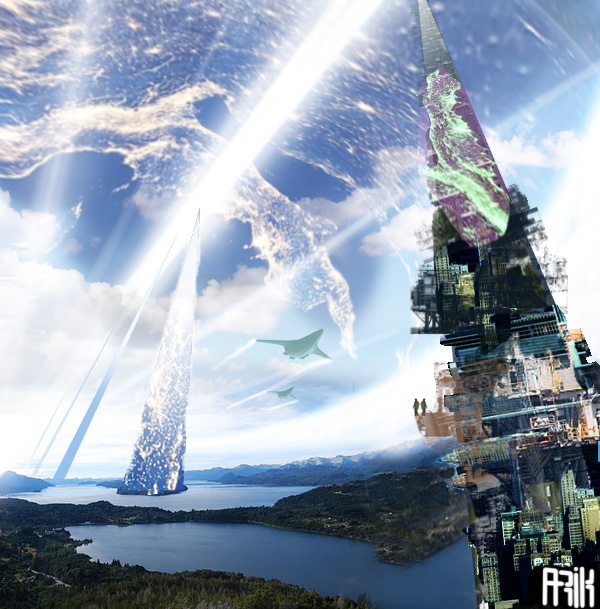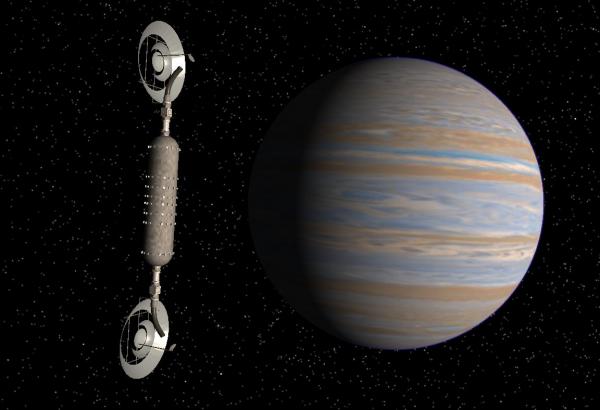BY LETTER
McKendree Cylinder
Technology > Technology Type or Material > Drytech/Hylotech
Technology > Technology Levels > High Tech / Hitech
Technology > Application > Infrastructure
Technology > Application > Megascale Engineering
Technology > Technology Type or Material > Nanotech
Technology > Technology Levels > High Tech / Hitech
Technology > Application > Infrastructure
Technology > Application > Megascale Engineering
Technology > Technology Type or Material > Nanotech
Rotating cylindrical habitats up to 10,000 km long | |
 Image from Worldtree | |
| Looking along the length of a McKendree cylinder, The axial lighting array can be seen, as well as intra-habitat structures reaching up to the hub. | |
Closed, rotating cylindrical habitats have been built since the Interplanetary age; at first these were no more than a hundred metres or so in radius, the smallest possible radius that could give Earth-like internal centrifugal gravity while avoiding excessive coriolis effects. But over time the habitats became larger, until they reached the maximum possible size for habitats constructed with non-exotic materials.
A McKendree Cylinder is designed much like an O'Neill Cylinder but built with the carbon buckytube technology used in Bishop Rings. As such McKendree Cylinders with an interior gravity of one standard gee can have a radius of 1,000 km and a length of 10,000 km. This radius and length will give a single McKendree Cylinder more than 62,857,000 km2 of living area or about 12% of the surface area found on a Gaian type planet. [Please note: first century hu are reported to have lived on only 10% of the surface of eir home world (Earth) due to inconvenient surface features - oceans, mountains, deserts, icecaps, etc. On the other hand these hu did draw on the planet's whole biosphere for life support.]
 Image from Steve Bowers | |
| A double, nested McKendree Cylinder ten thousand kilometers in length (note: the second, counter-rotating cylinder is inside the first) | |
However McKendree Cylinders can also be linked into counter-rotating pairs which may be side-by-side like the original O'Neill colony design or nested with a counter-rotating inner cylinder (or several). If a counter-rotating cylinder is included inside the outermost shell, the two layers must be separated by at least 50 kilometres of vacuum above the top of the atmosphere to eliminate atmospheric drag effects. Doubling the cylinder in this way increases the living area and counters gyroscopic effects so that the cylinders can be oriented in any chosen direction. (For example with their axis pointed towards the local star for easier direct lighting.)
When multiple levels or floors are added to the design a McKendree colony can quickly equal a Gaian type planet in total surface area. 'Ceiling height' in a multi-floor colony is generally determined by its psychological effects on the inhabitants but in the counter-rotating nested designs an inner cylinder must clear the rimwalls and upper atmosphere of the cylinder below it. This requires more than fifty kilometers between levels in a standard gee habitat; habitats with lower values of gravity can be larger, but the separation between the levels must be greater, as the scale height of the atmosphere is greater in low gravity conditions.
 Image from Steve Bowers | |
| Stadener Habitat, an early McKendree cylinder 1000 km in length with extensive light collection facilities at each end, opened by Ruby Marine in 2764 AT | |
A full-sized McKendree habitat can be constructed from a large asteroid or dwarf planet, or from a number of smaller objects. A typical dwarf planet of 1000 kilometres diameter can contain enough material to build 12 Mckendree cylinders, with a potential population of hundreds of billions of sophonts.
The interior of a McKendree cylinder may contain landscape features such as seas, lakes, hills, and even mountains; but these items add mass to the habitat and therefore increase the load on the buckytube fibres holding the cylinders together. To cut down on the additional load, the landscape is constructed with internal voids and arches, to make the hills and mountains as hollow as possible; these internal voids can be useful for storage.
The McKendree habitat was named after a 1st century AT human baseline, Tom McKendree, who first outlined the concept.
Related Articles
- Banks' Orbital
- Bernal Sphere
- Bishop Ring
- Monroe Cylinder - Text by Anders Sandberg
Major habitat / polity in a polar orbit around Green (Beta Virginis V). Once an important media center with strong links to the Nova Terra mediacorps, it has been since the ComEmp period something of a bit of a retirement resort, slightly "out of the way" in interplanetary traffic but an important meeting place for the owners of the major corporations, high society and the political networks. Regarded as awfully passé by most young and "hip" people in the system, and especially by Pacificans. - O'Neill Cylinder
- Orbital (habitat)
- Orbital (political unit) - Text by M. Alan Kazlev
Originally, a nation state or city state based on habitats in orbit around Old Earth. Over the course of the Interplanetary Age the term came to be used for any such state in Solsys. By early First Federation times the term Orbital was used more broadly for any independent or semi-independent state based on a hab in orbit around a planet. - Rotating Space Habitats
- Ruby Marine
- Sagan Prime
- Stanford Torus
- Sunclouds
- Tar Vara Habitats
Appears in Topics
Development Notes
Text by AI Vin with additions by Steve Bowers
Initially published on 09 October 2006.
see Tom McKendree's original papers here:
Implications of Molecular Nanotechnology Technical Performance Parameters on Previously Defined Space System Architectures
Appropriately Ambitious Aerospace Goals
Fiction that includes a McKendree Cylinder
Dirty Hands
Initially published on 09 October 2006.
see Tom McKendree's original papers here:
Implications of Molecular Nanotechnology Technical Performance Parameters on Previously Defined Space System Architectures
Appropriately Ambitious Aerospace Goals
Fiction that includes a McKendree Cylinder
Dirty Hands







